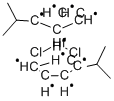BIS(CYCLOPENTADIENYL)HAFNIUM DICHLORIDE
Synonym(s):Di(cyclopentadienyl)hafnium(IV) dichloride;Hafnocene dichloride
- CAS NO.:12116-66-4
- Empirical Formula: C10H10Cl2Hf10*
- Molecular Weight: 379.58
- MDL number: MFCD00001438
- EINECS: 235-177-5
- SAFETY DATA SHEET (SDS)
- Update Date: 2024-12-18 14:08:57

What is BIS(CYCLOPENTADIENYL)HAFNIUM DICHLORIDE?
Chemical properties
white to light brown crystals or crystalline
The Uses of BIS(CYCLOPENTADIENYL)HAFNIUM DICHLORIDE
Starting material to prepare many kinds of hafnocene(II or IV) derivatives; in combination with AgI salt, is an effective activator for glycosyl fluoride. Pharmaceutical intermediates and alos used in chemical research.
Properties of BIS(CYCLOPENTADIENYL)HAFNIUM DICHLORIDE
| Melting point: | 230-233 °C |
| Boiling point: | 339.81°C (rough estimate) |
| solubility | Soluble in aromatic solvents, chloroform; slightly soluble in THF, ether. Insolble in hexanes. |
| form | crystal |
| color | off-white |
| Sensitive | Air & Moisture Sensitive |
| Hydrolytic Sensitivity | 7: reacts slowly with moisture/water |
| Exposure limits | ACGIH: TWA 0.5 mg/m3 NIOSH: IDLH 50 mg/m3; TWA 0.5 mg/m3 |
| CAS DataBase Reference | 12116-66-4(CAS DataBase Reference) |
| NIST Chemistry Reference | Bis(«eta»5-cyclopentadienyl)hafnium dichloride(12116-66-4) |
| EPA Substance Registry System | Hafnium, dichlorobis(.eta.5-2,4-cyclopentadien-1-yl)- (12116-66-4) |
Safety information for BIS(CYCLOPENTADIENYL)HAFNIUM DICHLORIDE
| Signal word | Warning |
| Pictogram(s) |
 Exclamation Mark Irritant GHS07 |
| GHS Hazard Statements |
H315:Skin corrosion/irritation H319:Serious eye damage/eye irritation H335:Specific target organ toxicity, single exposure;Respiratory tract irritation |
| Precautionary Statement Codes |
P261:Avoid breathing dust/fume/gas/mist/vapours/spray. P264:Wash hands thoroughly after handling. P264:Wash skin thouroughly after handling. P271:Use only outdoors or in a well-ventilated area. P280:Wear protective gloves/protective clothing/eye protection/face protection. P302+P352:IF ON SKIN: wash with plenty of soap and water. P305+P351+P338:IF IN EYES: Rinse cautiously with water for several minutes. Remove contact lenses, if present and easy to do. Continuerinsing. |
Computed Descriptors for BIS(CYCLOPENTADIENYL)HAFNIUM DICHLORIDE
New Products
4-Fluorophenylacetic acid 4-Methylphenylacetic acid N-Boc-D-alaninol N-BOC-D/L-ALANINOL Tert-butyl bis(2-chloroethyl)carbamate 3-Morpholino-1-(4-nitrophenyl)-5,6-dihydropyridin- 2(1H)-one Furan-2,5-Dicarboxylic Acid Tropic acid S-2-CHLORO PROPIONIC ACID ETHYL ISOCYANOACETATE 2-Bromo-1,3-Bis(Dimethylamino)Trimethinium Hexafluorophosphate (6-METHYL-[1,3]DITHIOLO[4,5-b]QUINOXALIN-2-ONE INDAZOLE-3-CARBOXYLIC ACID 4-IODO BENZOIC ACID (2-Hydroxyphenyl)acetonitrile 4-Bromopyrazole 5,6-Dimethoxyindanone 2-(Cyanocyclohexyl)acetic acid 4-methoxy-3,5-dinitropyridine 2-aminopropyl benzoate hydrochloride 1-(4-(aminomethyl)benzyl)urea hydrochloride diethyl 2-(2-((tertbutoxycarbonyl)amino) ethyl)malonate tert-butyl 4- (ureidomethyl)benzylcarbamate Ethyl-2-chloro((4-methoxyphenyl)hydrazono)acetateRelated products of tetrahydrofuran








You may like
-
 Bis(cyclopentadienyl)hafnium dichloride CAS 12116-66-4View Details
Bis(cyclopentadienyl)hafnium dichloride CAS 12116-66-4View Details
12116-66-4 -
 Bis(cyclopentadienyl)hafnium dichloride CAS 12116-66-4View Details
Bis(cyclopentadienyl)hafnium dichloride CAS 12116-66-4View Details
12116-66-4 -
 Bis(cyclopentadienyl)hafnium dichloride CAS 12116-66-4View Details
Bis(cyclopentadienyl)hafnium dichloride CAS 12116-66-4View Details
12116-66-4 -
 Hafnocene Dichloride CAS 12116-66-4View Details
Hafnocene Dichloride CAS 12116-66-4View Details
12116-66-4 -
 Bis(cyclopentadienyl)hafnium dichloride 95% CAS 12116-66-4View Details
Bis(cyclopentadienyl)hafnium dichloride 95% CAS 12116-66-4View Details
12116-66-4 -
 Bis(cyclopentadienyl)hafnium(IV) dichloride CAS 12116-66-4View Details
Bis(cyclopentadienyl)hafnium(IV) dichloride CAS 12116-66-4View Details
12116-66-4 -
 14714-50-2 (2-Hydroxyphenyl)acetonitrile 98+View Details
14714-50-2 (2-Hydroxyphenyl)acetonitrile 98+View Details
14714-50-2 -
 118753-70-1 98+View Details
118753-70-1 98+View Details
118753-70-1
Statement: All products displayed on this website are only used for non medical purposes such as industrial applications or scientific research, and cannot be used for clinical diagnosis or treatment of humans or animals. They are not medicinal or edible.